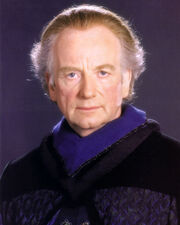
Palpatine was the most influential Naboo in history.
- "Wesa no like da Naboo. Da Naboo tink day so smarty. Day tink day brains so big."
- ―Boss Nass
The Naboo (Singular 'Naboo') were the Human inhabitants of the planet Naboo. They were not native to the world, but they became the dominant intelligent life-form there.
History
The Naboo descended from the Grizmalltian Humans who fled a violent revolution on their planet. Led by spacer Kwilaan, they colonized Naboo and settled in the mountains and great grass plains around 3,900 BBY and had little contact to the native Gungans.
Cultural differences led to tension between the two peoples—but direct conflict was rare. Over time there was more conflict between the various Human settlements than between the Naboo and Gungans. The Gungans believed the Naboo to be 'pompous cowards' while the Naboo believed the Gungans to be 'barbarians'. This attitude lasted until Queen Amidala united the Gungans and Naboo to fight the Trade Federation in the Battle of Naboo.
Naboo politics often involved large numbers of teenaged Naboo in government work, a result of the Naboo ideal of valuing inner purity and innocence over political ability. This often resulted in individuals receiving positions far beyond their own level of competence and being left vulnerable to manipulation, such as the case of Queen Amidala and Senator Palpatine.
Culture

The city of Theed, capital of Naboo.
Historically the Naboo were a pastorial and nomadic people, migrating in tribes and clans on the vast "oceanic" grass-plains, with few settlements of substance. Tribes traced their decent from the colony vessels that brought them to Naboo, and clans traced decent from the founding settlers. The Naboo continue to place great value on genealogical decent, though by the era of Queen Amidala few families can trace their history to the original colonists with any certainty.
The Naboo developed into a classic feudal society with an hereditary noble class and common folk, though unlike most feudal societies, there is no record of a subservient serf class. Naboo city-states traded with each other and with the Gungans. Generally the city-states acknowledged a ceremonial "High King"—a position that at times rotated between the tribal or city-state princes, though at other times was vested in an hereditary royal house. This ceremonial position was largely powerless and a form of peerage democracy evolved, though by the time of King Jafan the position became more substantal.
The Naboo eventually became known for being peaceful, enlightened, and artistic, among other things.
Adulthood and the right to vote is based on intellectual maturity rather than biological age, hence a reason for so many teenagers being involved in public service. The Naboo display a remarkable--perhaps unique--tendency to elect extremely young women to high public office (Queen and Senator Padmé Amidala, Queen Jamillia, Queen Apailana, Senator Pooja Naberrie).
Settlements and regions
Despite nomadic elements in early Naboo society, eventually more substantial settlements emerged along trade routes and river crossings, or at defensible citadels, such as Dee'ja Peak in the Gallo Mountains. As one of the first human settlements on the planet, Dee'ja Peak retains a degree of prestige and reverence long after political power shifted to Theed. Keren and Theed both developed as farming communities whose over-production of foodstuffs provided for a large leisure class. Keren eventually became the commercial hub while Theed became more aristocratic. Kaadara developed as a coastal town for the few Nabooan fisherman (not to be confused with nabooian). Moenia was the first, and only, human colony built in the traditional Gungan homelands of the Lianorm Swamps.

A Naboo symbol
The geographic features of the planet define the regions of the grass plains in the north, the mountains in the center, and the swamps and bayous in the south.
The northern grass plains border the northern ocean, and are divided into regional provinces of the Great Grass Plains with Theed the major city, the Eastern Great Grass Plains with few settlements, and the Western Great Grass Plains with the seaside community of Kaadera and the commercial center of Keren. The Gallo Mountains regional province contains Dee'ja Peak and the Varykino, known as the Lake Retreat in the Lake District, while the vast Lianorm Swamp dominate the south with the city of Moenia the regional capital. The Emperor Palpatine maintains an Imperial Retreat on a dormant plasmic volcanic caldera in this region.
Religion
see also Naboo religion, Brotherhood of Cognizance
The polytheistic Naboo worship many allegorical deities, such as the goddess of Safety. The deity of Shiraya reflects many aspects common to lunar worship found in many human cultures. However, the Mother Vima occupies the paramount throne in the pantheon of Naboo gods as the Mother goddess, or Gia, common in many religious traditions.
Naboo Ancient philosophers are revered and honored as enlightened gurus, and with the reverence of family ancestors, form an important aspect in Naboo religious traditions. Paired statues of semi-legendary or archtypical gurus are prominently displayed in ranks on either side of the steps leading to the Theed Royal Palace.
Many devoted holymen and holywomen form monastic communities and orders, such as the Brotherhood of Cognizance, which focus on a particular deity or an enlightened guru. These religious orders are governed by a pontifex, and have a monastic heirachy typical of many human religious orders. Often the more ascetic orders may be found in remote and isolated locations, preferring a life spent in solitude, without worldly distraction and centered on peaceful contemplation.
Famous Naboo
Military
RSF
- Ric Olié; RSF pilot
- Rhys Dallows; RSF pilot
- Magneta; RSF Captain
- Gregar Typho; RSF career
- Panaka; RSF Captain
Republican military personel
- Ronhar Kim; Jedi knight and Republican general
Imperial military personal
- Ronhar Kim
- Panaka; Imperial Moff
- Sate Pestage
- Kinman Doriana
Monarchs
Other notables
- Arani Korden; Naboo noble
- Darred Janren; business leader
- Jobal Thule Naberrie
- Omar Berenko; wealthy noble and controversial poet
- Ryoo Thule
- Ruwee Naberrie; educator
- Ryoo Naberrie
- Sola Naberrie: civil engineer
- Winama Naberrie
Politicians
- Graf Zapalo; a Master of Sciences
- Hela Brandes; Music Advisor
- Horace Vancil; political and economic advisor
- Hugo Eckener; Chief Architect
- Kun Lago; prime counselor (Governor)
- Ian Lago; Palace page
- Kyu Tane; Minister of Culture
- Lufta Shif; Education Advisor
- Palpatine/Darth Sidious; Senator, Surpream Chancelor, and Galactic Emperor
- Pooja Naberrie
- Ruto Graven; Assistant Minister of Internal Affairs for Queen Amidala.
- Sio Bibble; Govenor
- Vidar Kim; Senator
Appearances
- A Summer's Dream
 "The Starfighter Trap" — Star Wars Gamer 1
"The Starfighter Trap" — Star Wars Gamer 1- Star Wars: Starfighter
- Star Wars Episode I: The Phantom Menace novel (First identified as Naboo (people))
- Star Wars Episode I: The Phantom Menace
- Star Wars Episode I: The Phantom Menace junior novel
- LEGO Star Wars: The Video Game (Non-canonical appearance)
- LEGO Star Wars: The Complete Saga (Non-canonical appearance)
 "Deep Spoilers" — Star Wars Gamer 4
"Deep Spoilers" — Star Wars Gamer 4- Star Wars Episode II: Attack of the Clones
- Star Wars Episode III: Revenge of the Sith
- Star Wars Empire 19: Target: Vader
- The Last of the Jedi: Death on Naboo
- LEGO Star Wars II: The Original Trilogy (Non-canonical appearance)
- Star Wars Episode V: The Empire Strikes Back (First appearance)
- Star Wars Episode VI: Return of the Jedi
- Star Wars: Galactic Battlegrounds
Sources
- Secrets of Naboo
- Star Wars Official Poster Monthly 1
- Star Wars: The Complete Visual Dictionary
- Star Wars Gamer 1
